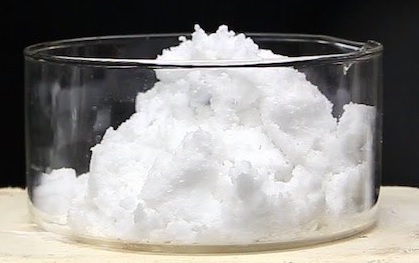| Physical Properties | Lithium hydroxide is a white tetragonal crystals; refractive index 1.464; density 1.46 g/cm3; melts at 450°C; decomposes at 924°C; dissolves in water (12.8g/100g at 20°C and 17.5 g/100g at 100°C); slightly soluble in alcohol.

Lithium hydroxide monohydrate is white monoclinic crystalline solid; refractive index 1.460; density 1.51 g/cm3; soluble in water, more soluble than the anhydrous salt (22.3g and 26.8g/100g at 10 and 100°C, respectively); slightly soluble in alcohol; insoluble in ether.
|
| Uses | Lithium hydroxide is used as an electrolyte in certain alkaline storage batteries; and in the production of lithium soaps. Other uses of this compound include its catalytic applications in esterification reactions in the production of alkyd resins; in photographic developer solutions; and as a starting material to prepare other lithium salts.
|
| Preparation | Lithium hydroxide is prepared by the reaction of lithium carbonate with calcium hydroxide:
Li2CO3 + Ca(OH)2 → 2LiOH + CaCO3
Calcium carbonate is filtered out and the solution is evaporated and crystallized.
The product obtained is the monohydrate, LiOH•H2O. The anhydrous compound is obtained by heating the hydrate above 100°C in vacuum or carbon dioxide-free air.
The hydroxide also may be prepared by treating lithium oxide with water.
|
| Reaction | Lithium hydroxide is a base. However, it is less basic than sodium or potassium hydroxide.
The compound undergoes neutralization reactions with acids:
LiOH + HCl → LiCl + H2O
Heating the compound above 800°C in vacuum yields lithium oxide:
2LiOH Li2O + H2O
Lithium hydroxide readily absorbs carbon dioxide, forming lithium carbonate:
2LiOH + CO2 → Li2CO3 + H2O
Passing chlorine through a solution of lithium hydroxide yields lithium hypochlorite:
LiOH + Cl2 → LiOCl + HCl
Saponification of fatty acids with lithium hydroxide produces lithium soaps.
LiOH + CH3(CH2)16COOH → CH3(CH2)16COOLi + H2O
(stearic acid) (lithium stearate)
|
| Chemical Properties | lithium hydroxide (LiOH) is a white solid made industrially as the monohydrate (LiOH.H2O) by reacting lime with a lithium ore or with a salt made from the ore. Lithium hydroxide has a closer resemblance to the group 2 hydroxides than to the group 1 hydroxides. |
| Physical properties | White tetragonal crystals; refractive index 1.464; density 1.46 g/cm3; melts at 450°C; decomposes at 924°C; dissolves in water (12.8g/100g at 20°C and 17.5 g/100g at 100°C); slightly soluble in alcohol. The monohydrate is white monoclinic crystalline solid; refractive index 1.460; density 1.51 g/cm3; soluble in water, more soluble than the anhydrous salt (22.3g and 26.8g/100g at 10 and 100°C, respectively); slightly soluble in alcohol; insoluble in ether. |
| Uses | The compound is soluble in water. The compound is used in the formulation of lithium soaps used in multipurpose greases; also in the manufacture of various lithium salts; and as an additive to the electrolyte of alkaline storage batteries. LiOH also is an efficient, light-weight absorbent for carbon dioxide. |
| Uses | Lithium hydroxide is used as a heat transfer medium, as a storage-battery electrolyte and also used for the production of lithium greases. It is also used in ceramics, in some portland cement formulations, in the absoption of carbondioxide from sealed enviornments such as submarines, spacecrafts and breathing apparatus. It is used in esterification reactions, as stabilizer in photographic developments and as a coolant in pressurized water reactors for corrosion control. |
| Uses | Lithium hydroxide is used in storage batteries and soaps and as CO2
absorber in spacecrafts. |
| Definition | A white crystallinesolid, LiOH, soluble in water,slightly soluble in ethanol and insolublein ether. It is known as the monohydrate(monoclinic; r.d. 1.51) and inthe anhydrous form (tetragonal, r.d.1.46; m.p. 450°C; decomposes at924°C). The compound is made by reacting lime with lithium salts orlithium ores. Lithium hydroxide isbasic but has a closer resemblance togroup 2 hydroxides than to the othergroup 1 hydroxides (an example ofthe first member of a periodic grouphaving atypical properties). |
| General Description | A clear to water-white liquid which may have a pungent odor. Contact may cause severe irritation to skin, eyes, and mucous membranes. Lithium hydroxide may be toxic by ingestion, inhalation and skin absorption. Lithium hydroxide is used to make other chemicals. |
| Air & Water Reactions | Dilution with water may generate enough heat to cause steaming or spattering. |
| Reactivity Profile | LITHIUM HYDROXIDE SOLUTION neutralizes acids exothermically to form salts plus water. Reacts with certain metals (such as aluminum and zinc) to form oxides or hydroxides of the metal and generate gaseous hydrogen. May initiate polymerization reactions in polymerizable organic compounds, especially epoxides. May generate flammable and/or toxic gases with ammonium salts, nitrides, halogenated organics, various metals, peroxides, and hydroperoxides. May serve as a catalyst. Reacts when heated above about 84°C with aqueous solutions of reducing sugars other than sucrose, to evolve toxic levels of carbon monoxide [Bretherick, 5th Ed., 1995]. |
| Health Hazard | TOXIC; inhalation, ingestion or skin contact with material may cause severe injury or death. Contact with molten substance may cause severe burns to skin and eyes. Avoid any skin contact. Effects of contact or inhalation may be delayed. Fire may produce irritating, corrosive and/or toxic gases. Runoff from fire control or dilution water may be corrosive and/or toxic and cause pollution. |
| Fire Hazard | Non-combustible, substance itself does not burn but may decompose upon heating to produce corrosive and/or toxic fumes. Some are oxidizers and may ignite combustibles (wood, paper, oil, clothing, etc.). Contact with metals may evolve flammable hydrogen gas. Containers may explode when heated. |
| Safety Profile | Poison by ingestion and
subcutaneous routes. Mtldly toxic by
inhalation. A corrosive. When heated to
decomposition it emits toxic fumes of Li. |
| Purification Methods | It crystallises from hot water (3mL/g) as the monohydrate. It is dehydrated at 150o in a stream of CO2-free air. It sublimes at 220o with partial decomposition [Cohen Inorg Synth V 3 1957, Bravo Inorg Synth VII 1 1963]. |



